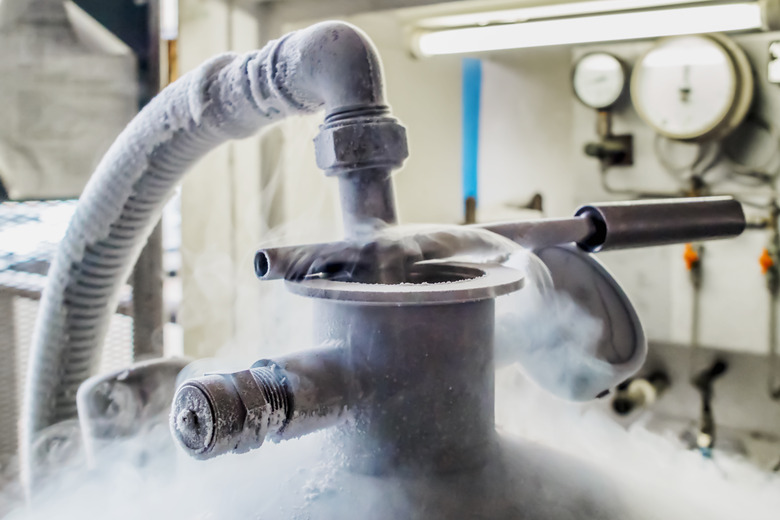Physical Properties Of Nitrogen Gas
Nitrogen makes up the bulk of earth's atmosphere: 78.1 percent by volume. It is so inert at standard temperature and pressure that it was termed "azote" (meaning "without life") in Antoine Lavoisier's Method of Chemical Nomenclature. Nevertheless, nitrogen is a vital part of food and fertilizer production and a constituent of the DNA of all living things.
Characteristics
Characteristics
Nitrogen gas (chemical symbol N) is generally inert, nonmetallic, colorless, odorless and tasteless. Its atomic number is 7, and it has an atomic weight of 14.0067. Nitrogen has a density of 1.251 grams/liter at 0 C and a specific gravity of 0.96737, making it slightly lighter than air. At a temperature of -210.0 C (63K) and a ressure of 12.6 kilopascals, nitrogen reaches its triple point (the point an element can exist in gaseous, liquid and solid forms simultaneously).
Other States
Other States
At temperatures below nitrogen's boiling point of -195.79 C (77K), gaseous nitrogen condenses into liquid nitrogen, a fluid that resembles water and remains odorless and colorless. Nitrogen solidifies at a melting point of -210.0 C (63K) into a fluffy solid resembling snow.
Molecular Bonding
Molecular Bonding
Nitrogen forms trivalent bonds in most compounds. In fact, molecular nitrogen exhibits the strongest possible natural triple bond due to the five electrons in the outer shell of the atom. This strong triple bond, along with nitrogen's high electronegativity (3.04 on the Pauling scale), explains its nonreactivity.
Uses
Uses
Nitrogen gas is useful in industrial and production settings due to its abundance and nonreactivity. In food production, nitrogen gas suppression systems can extinguish fires without fear of contamination. Iron, steel and electronic components, which are sensitive to oxygen or moisture, are produced in a nitrogen atmosphere. Nitrogen gas is commonly combined with hydrogen gas to produce ammonia.
Potential
Potential
In 2001, "Nature" reported that Carnegie Institution of Washington scientists were able to transform gaseous nitrogen into a solid state by subjecting the gaseous form to intense pressure. The researchers pressed a sample of nitrogen between two pieces of diamond with a force equivalent to 1.7 million times that of atmospheric air pressure, transforming the sample into a clear solid resembling ice, but with a crystal structure like that of diamond. At temperatures below -173.15°C (100K) the sample remained a solid when pressure was removed. When it reverts back to gaseous state nitrogen releases great amounts of energy, leading physics professor Dr. Richard M. Martin to speculate on its use as a rocket fuel.
Cite This Article
MLA
Johnson, Erik. "Physical Properties Of Nitrogen Gas" sciencing.com, https://www.sciencing.com/physical-properties-nitrogen-gas-2719/. 5 April 2018.
APA
Johnson, Erik. (2018, April 5). Physical Properties Of Nitrogen Gas. sciencing.com. Retrieved from https://www.sciencing.com/physical-properties-nitrogen-gas-2719/
Chicago
Johnson, Erik. Physical Properties Of Nitrogen Gas last modified March 24, 2022. https://www.sciencing.com/physical-properties-nitrogen-gas-2719/
